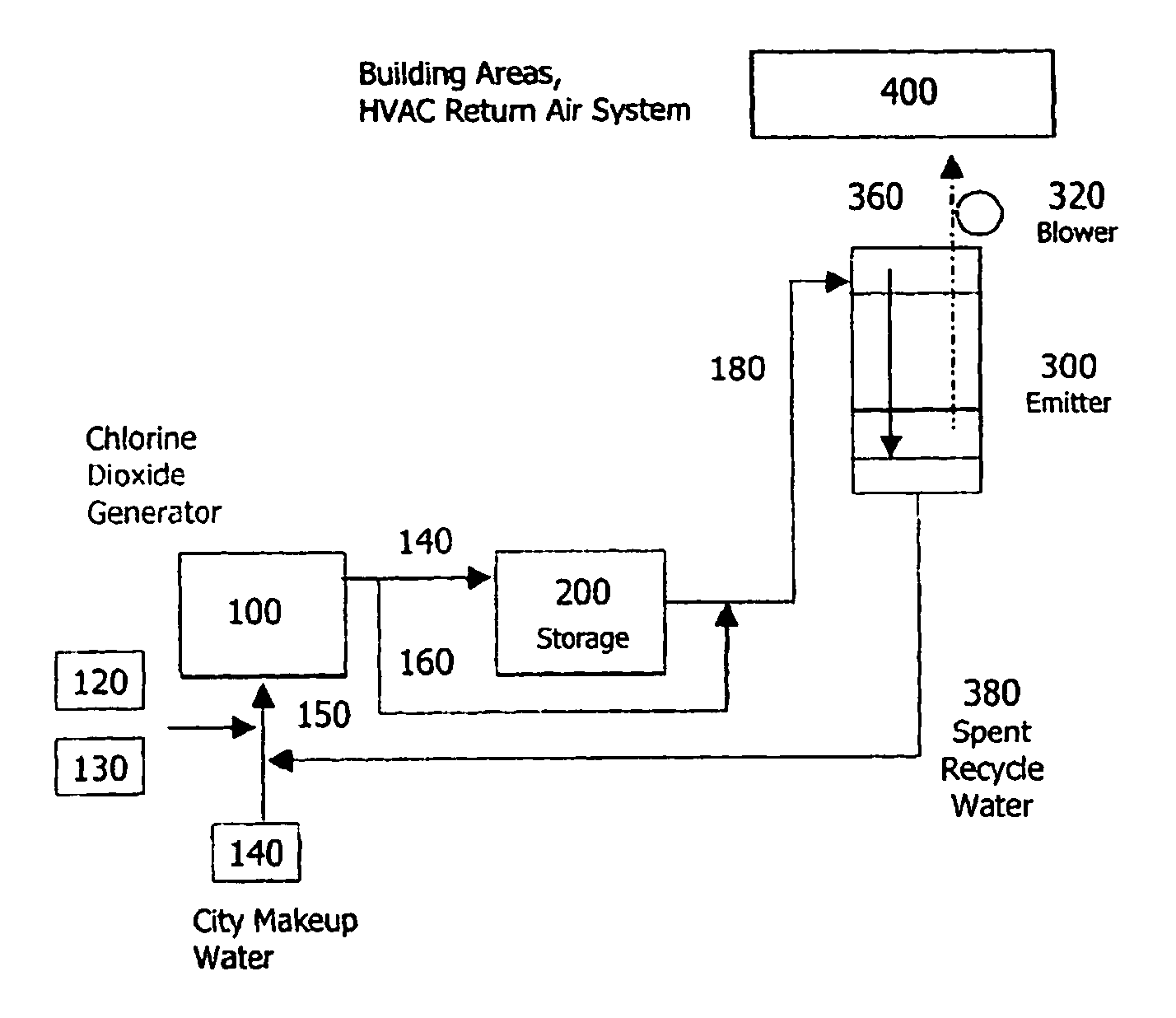Methods of using chlorine dioxide as a fumigant
a technology of chlorine dioxide and fumigant, which is applied in the direction of disinfection, lavatory sanitory, chemistry apparatus and processes, etc., can solve the problems of limiting the utility of large volume fumigation, poor penetration ability, and potential explosive formaldehyde, etc., and achieves the effect of lowering the concentration of chlorine dioxide and lowering the flow rate of chlorine dioxide solution
- Summary
- Abstract
- Description
- Claims
- Application Information
AI Technical Summary
Benefits of technology
Problems solved by technology
Method used
Image
Examples
example 1
[0029]The environment within the enclosed volume of a trailer is fumigated and restored to habitability as follows. Initially, the environment is climatized to a temperature of 70-80° F. and a relative humidity of 60-80%. During treatment, chlorine dioxide is introduced into the volume to be fumigated and maintained at a residual level of 500 ppm V for 10 hours. In other embodiments, the residual chlorine dioxide level is maintained at about 750 ppm V, about 1000 ppm V or about 3000 ppm V and the treatment time is in the range of about 8 to about 12 hours. Typically, if the enclosed volume is 2280 ft3, air is suitably recirculated at 5 CFM. The treatment is conducted in reduced illumination, preferably substantially dark, to minimize the decomposition of chlorine dioxide to chlorine. Suitably chlorine dioxide gas is present at a concentration in the introduced gas of at least 90%, preferably at least 95%, and optimally at least 99%.
[0030]If the space to be fumigated contains materia...
example 2
[0031]The environment within an enclosed volume was fumigated and restored to habitability as follows. HVAC equipment is inspected and fans readied. All filters are removed and burned. Cooling and heating coils are sprayed with degreaser / detergent. The environment is climatized for 2.5 hours to a temperature of 60-80° F., suitably about 75° F., and a relative humidity of 70-80%, suitably about 75%. The pH of the city water is adjusted to 6.5-7.0 to allow the emitters to deliver free ClO2 into the air. The building is sealed with strippable foam and air loss rate measure and used to correct the calculated chlorine dioxide dosage needed for fumigation.
[0032]Additional internal fans are placed in positions determined by modeling to assist the HVAC in approaching ideal mixing. Chlorine dioxide is introduced with an air flow rate of 2,000 CFM and maintained at a level of 500 ppm for about 12 hours. The initial charge of the enclosed volume with chlorine dioxide is rapid to prevent any pa...
PUM
| Property | Measurement | Unit |
|---|---|---|
| temperature | aaaaa | aaaaa |
| volume | aaaaa | aaaaa |
| temperature | aaaaa | aaaaa |
Abstract
Description
Claims
Application Information
 Login to View More
Login to View More - R&D
- Intellectual Property
- Life Sciences
- Materials
- Tech Scout
- Unparalleled Data Quality
- Higher Quality Content
- 60% Fewer Hallucinations
Browse by: Latest US Patents, China's latest patents, Technical Efficacy Thesaurus, Application Domain, Technology Topic, Popular Technical Reports.
© 2025 PatSnap. All rights reserved.Legal|Privacy policy|Modern Slavery Act Transparency Statement|Sitemap|About US| Contact US: help@patsnap.com


